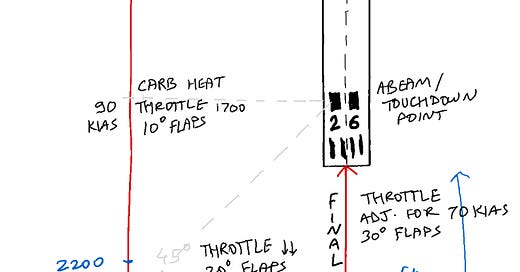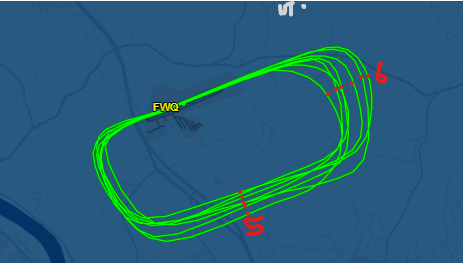A lot of practice, a bad day, and a better day - that pretty much sums up my last lesson. It was a long lesson, split over 3 days. I practiced a lot of traffic patterns - total of 16. Towards the end I did find some consistency on my traffic pattern legs and that is what I was/am aiming for. This time, rather than indulging in what all went wrong, I am going to describe what I am aspiring for - a consistent traffic pattern that I am able to do over and over again.
My dream traffic pattern.
I have flown this traffic pattern so many times in my dreams, and finally, in last three attempts, I got the closest to it. Let me show you visually what I am talking about.
This is how it goes. As I prepare for take-off, I line myself up with the runway 26. I usually take-off from runway 26 and do a left-closed traffic. As I line up with the runway center line, I put in full throttle. The airplane speeds up and I see that airspeed gauge suddenly comes alive and starts rocking. As airplane picks up the airspeed, the nose slowly starts to drift towards left due to P-factor. I anticipate it and apply right rudder pedal to bring the nose back on the centerline. Soon, the plane crosses airspeed of 52 knots and I rotate. I pull back the yoke gently, but firmly and watch the plane become airborne. I feel the traction between the tires and the runway ceases and below, I watch the runway gets farther and farther away. I keep the nose on the center-line of the runway by applying more right rudder pedal and continue to climb. At this point, I also bug my heading in the Garmin G5, to track my headings and turns.
I am now shooting for 72 knots as it is the best rate of climb speed for Cessna 172 that I usually fly. As I continue my upwind, soon I reach 72 knots and at that point I trim some pressure off by applying nose-up trim. I watch the airspeed stabilize to 72 knots, and now I wait to get to 1700 feet, which is when I start my crosswind turn. Soon, I reach 1700 feet and I gently start my crosswind turn. I also apply rudder to stabilize my turn. At this time, I am still climbing up while turning crosswind. As I track the heading bug approach 90 degree from its original position, I come out of the turn and level the wings. I am still climbing as I need to climb to traffic pattern altitude of 2200 feet. At the same time, I am also looking down from the window, to check on my ground references. I am going to wait until the green building of Rostraver Ice Garden is across me, because that is when I am going to start my downwind turn. While I check on my ground references, I am also glancing at my airspeed to make sure that I am at 72 knots, and glancing at vertical speed indicator to make sure that I am in fact climbing. If I reach 2200 ft. while on crosswind, so be it, I am going to level the nose in crosswind itself. Otherwise, as I see the Ice Garden building crossing behind me, I start my downwind turn. I keep an eye out on the runway as well as my heading bug to make sure that I am parallel to the runway as I come out of the turn in the downwind.
Now the waiting game starts. I know I have to do a bunch of things in the short span of time. As I reach 2200 feet, I take some throttle out and level the nose. As I watch my vertical speed indicator needle settle at 0, indicating I am not flying a straight and level flight, I also keep an eye out on captains bars on the runway. That is my touchdown point. As I get abeam with it, I pull the carb heat ON, and reduce the throttle down. I watch the airspeed reduce. As airspeed falls in the flaps extended range of 85 knots, I put 10 degrees of flaps. As I put the flaps in, I anticipate that the nose is going to balloon up and I put some forward pressure on the yoke to make sure that that doesn't happen. I see that my airspeed is bleeding down into upper 80s knots, or high 70s knots.
Now I keep glancing over my left shoulder towards the runway and the captains bars to gauge when I should start my base turn. That point is at about 45 degrees angle from the captains bars, and as I reach there, I push the nose forward to start my descent. As the descent starts, I start my base turn, I descend at 500 feet per minute, and while I descend, I keep glancing at my airspeed and heading bug. At about 90 degree from the runway, I need to level my wings for base turn. I have a ground reference for that too. At distance, there is a white water tank that stands out. As I see the water tank come up on the nose, I level the wings and glance out the window to make sure I am on my base leg. At this point, I am still descending at 500 feet per minute. I glance at my airspeed - it is around 80 knots. I reduce some more throttle and put in another notch of flaps. My count for that is “One one thousand two”, and stop. I glance at the flaps gauge to ensure that I have 20 degrees flaps in. Again, anticipating the balloon, I keep the forward pressure on the yoke to continue my descent.
As I see that I am goin to intercept the extended centerline of the runway, that's my cue to turn on the final. I check to my right, out the right window, to make sure no plane is on my trajectory, and to my relief - there is none. I announce “Final Clear” and start my turn to final. I am really gentle on the turn since I am really close to the ground. I do not want to spook anyone down there.
As I level my wings on the final, I have the runway in front of me. I see that I am on the centerline. The VASI lights show me “red over white” indicating that I am on glide path. I glance at my airspeed - it is still around 80 knots. I reduce some more throttle and add another notch of flaps. I now have 30 degrees of flaps. I see the airspeed getting down to 70 knots. “Perfect!” I say to myself. Now comes the really crucial part - fighting for that centerline while maintaining descent and airspeed. I use rudder to make sure my plane is well coordinated. I keep those captains bars in the middle of the windshield and continue to keep them there. I know that as long as they don't change on my windshield, I am good. I continue on.
Soon, I am over the runway threshold, and that is when I take all the power out. I pull out throttle to idle, and continue to descent. As runway gets near, it gets bigger and bigger, and at the correct moment, when I am only a few feet above the ground, I flare. That gentle backward pressure makes the plane float and float and float. I continue to hold that back-pressure and make sure the wings are level, and the plane is aligned with the runway. That's the dance with rudder pedals that I keep doing. After eternity of waiting, I hear a soft thud. That's the sweet sound of touchdown. I continue to steer the plane with rudder, making sure that I am still on the runway and on the centerline. I pull yoke back, slowly, applying some aerodynamic breaking.
Slowly plane loses all the airspeed and I exit via taxiway Bravo. I clean up the plane by putting carb heat off, and retracting flaps all the way up. Once I am clear of active runway, I announce so, and then continue to taxi back for another lap.
There you go - that is the traffic pattern that I yearn for. in the last lesson, I got very close to it, and I will continue to practice it until I can do it over and over again, consistently. The lines for my traffic pattern, need to look as one, and more uniform, rather than like below. I know I can do it.






You are getting it.